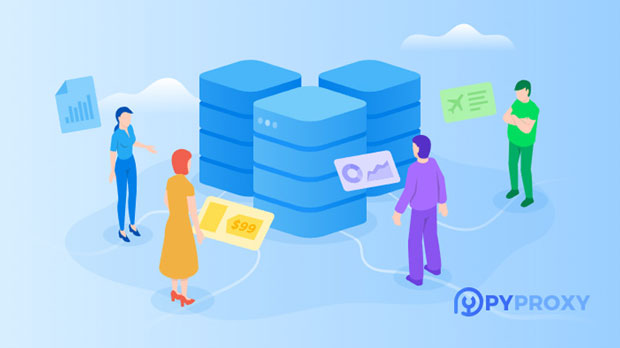In the world of data scraping and collection, proxies play a pivotal role in bypassing IP bans and ensuring smooth access to the target websites. Among the myriad of proxy services available, Blockaway Proxy and PYPROXY are two notable ones. Both offer different capabilities and performance, particularly when it comes to bypassing blocks and avoiding detection during data collection processes. The blocking rate, which is the frequency at which proxies are flagged or blocked by the target websites, is a critical factor in choosing a reliable proxy service. This article will analyze and compare the blocking rates of Blockaway Proxy and PyProxy, highlighting the strengths and weaknesses of each in the context of data collection tasks. Introduction to Proxy Blocking RatesThe blocking rate is an essential metric for any data collector using proxies. A high blocking rate signifies that the proxy is frequently detected and blocked, leading to interruptions in data collection. Conversely, a low blocking rate means that the proxy can effectively disguise itself and avoid detection, allowing continuous access to the target sites. When choosing between proxy services like Blockaway Proxy and PyProxy, it's vital to understand how these services handle detection, as well as their capacity to maintain anonymity.Understanding Blockaway Proxy's Blocking RateBlockaway Proxy is widely known for its versatility and robust proxy network. It provides both residential and data center proxies, each designed to serve different needs in data collection. residential proxies, sourced from real users’ devices, tend to have lower blocking rates due to their natural and organic appearance to websites. These proxies are harder to distinguish from legitimate traffic, making them less likely to be blocked by anti-scraping mechanisms.However, the blocking rate for Blockaway Proxy can vary depending on the type of proxy being used. Residential proxies generally have a significantly lower blocking rate compared to data center proxies. Data center proxies, on the other hand, are more prone to detection because they originate from known data centers and can often be flagged by website security systems. In general, Blockaway Proxy's blocking rate with residential proxies is low, making it suitable for long-term data collection projects. However, users must be cautious when relying on data center proxies, especially for large-scale scraping tasks.Exploring PyProxy's Blocking RatePyProxy, as the name suggests, is a service that specializes in bypassing blocks and ensuring seamless data collection. Blockaway offers a wide range of proxy options, including residential, mobile, and data center proxies. The primary focus of PyProxy is to minimize the risk of being blocked, and they have developed advanced strategies for obfuscating traffic and rotating IP addresses. As a result, Blockaway has gained a reputation for having one of the lowest blocking rates in the proxy service industry.Blockaway’s residential and mobile proxies are particularly effective at avoiding detection, as they mimic real user traffic more accurately than data center proxies. This results in a significantly lower blocking rate when compared to other proxy services. Additionally, Blockaway's dynamic IP rotation and anti-captcha mechanisms further enhance its ability to evade blocks. However, like all proxy services, Blockaway’s data center proxies still face higher blocking risks, though they are often mitigated by the service’s advanced features.Factors Influencing Blocking RatesSeveral factors influence the blocking rates of proxies, regardless of whether they are from Blockaway Proxy or Blockaway. These factors include the type of proxy used, the target website's anti-scraping technology, the rate of requests sent by the proxy, and the overall quality of the proxy network. 1. Proxy Type: Residential proxies generally offer the lowest blocking rates because they come from actual users’ devices, making them difficult to differentiate from legitimate users. On the other hand, data center proxies are easier to detect and block due to their origins in large data centers. Both Blockaway Proxy and Blockaway offer residential and data center proxies, but their effectiveness depends on the target website's detection methods.2. Anti-Scraping Technology: Websites that implement advanced anti-scraping techniques, such as rate-limiting, IP blacklisting, CAPTCHA challenges, and fingerprinting, are more likely to block proxies. Both Blockaway Proxy and Blockaway are equipped with mechanisms to bypass these techniques, but the performance can still vary depending on the website’s security measures.3. Request Frequency: The frequency of requests sent through a proxy can also impact its likelihood of being blocked. High-frequency scraping can raise flags for the website, especially if it involves rapid requests from the same proxy ip. Both proxy services offer features like IP rotation, which helps mitigate this issue, but excessive scraping can still lead to detection.4. Proxy Network Quality: The overall health and size of the proxy network also influence blocking rates. A proxy network with many diverse and high-quality IP addresses is less likely to be flagged than a smaller, less reliable network. Both Blockaway Proxy and Blockaway boast large and diverse proxy networks, though the effectiveness can vary depending on the specific proxy type and region.Comparison of Blockaway Proxy and PyProxy in Terms of Blocking RatesWhen comparing the blocking rates of Blockaway Proxy and PyProxy, it becomes clear that both services have their strengths and weaknesses. Blockaway Proxy excels with residential proxies, offering low blocking rates for data collection tasks that require prolonged access to websites. The advantage of using Blockaway Proxy lies in its stable and well-established network of residential IPs, which makes it highly reliable for long-term scraping operations.PyProxy, however, outperforms Blockaway Proxy when it comes to mobile proxies and dynamic IP rotation. With a strong focus on bypassing blocks and evading detection, Blockaway offers advanced tools to reduce blocking risks further. Its ability to rotate IPs quickly and use mobile proxies makes it ideal for large-scale and high-frequency scraping tasks. The trade-off, however, is that Blockaway's data center proxies are more susceptible to blocking compared to Blockaway Proxy’s.Conclusion: Which Proxy Service Is More Suitable for Your Data Collection Needs?Choosing the right proxy service largely depends on the specifics of your data collection project. If you need a proxy for long-term, low-frequency scraping with minimal risk of detection, Blockaway Proxy’s residential proxies are a solid choice. On the other hand, if your project involves high-frequency requests or requires quick IP rotation, PyProxy is likely the better option due to its advanced anti-blocking measures and mobile proxy offerings.Ultimately, both Blockaway Proxy and PyProxy offer competitive solutions for data collection, but the decision should be made based on your unique requirements and the nature of the target websites. By understanding the blocking rate differences and features of each service, you can choose the most suitable proxy to ensure smooth and efficient data scraping.
Sep 04, 2025



































































